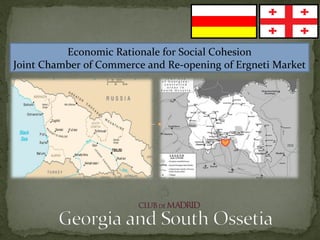
Georgia mande
- 1. Economic Rationale for Social Cohesion Joint Chamber of Commerce and Re-opening of Ergneti Market
- 3. Violent Conflict 2008 Aggravating factors South Ossetia’s demand for autonomy Restrictive economic policy: closure of the Ergneti Market/boundary line Political and Military interference and support (propping up) from outside actors High militarization of boundary line and region Biased and inflammatory media propaganda poverty Root Causes Georgian nationalist policies and hostility/ historical injustices to minorities Forced reunification of Georgia and S. Ossetia Background Divide and Rule by imperial powers 1996 Collapse of the Soviet Union and independence of Soviet republics
- 4. Actors Interests/Gains Internal Internal 1. Autonomous (rebel) Government of S. Ossetia 1.Autonomy, identity recognition 2. Georgian backed provisional government in S. 2. Security, power and control. Ossetia 3. Economic freedom and 3. S. Ossetia citizens living in S. Ossetia movement. 4. Georgian Citizens living in S. Ossetia 4. Security 5. Business entrepreneurs 5. Economic growth 6.Security forces 6. Control, security 7.Organized crime lords 7. financial gains External External Russian military and aid Energy, Transit Nato Security anti-contraband OSCE Allie in the region UN Military Occupation/Arms EU Military/Air force base USA Peacekeepers Financial
- 12. What lessons can be learned? Are the lessons meeting our goals in our theories of change. To what level were stakeholders involved in the M&E process. Did buy-in take place because of collaborative effort or due to media/social marketing efforts (both?). What are best practices from our project that are replicable. What were the outputs produced? Did we achieve our intended outcomes? What aspect of the project brought about the greatest change What were the unintended (positive or negative) outcomes from the project. Is the project sustainable upon completion.
